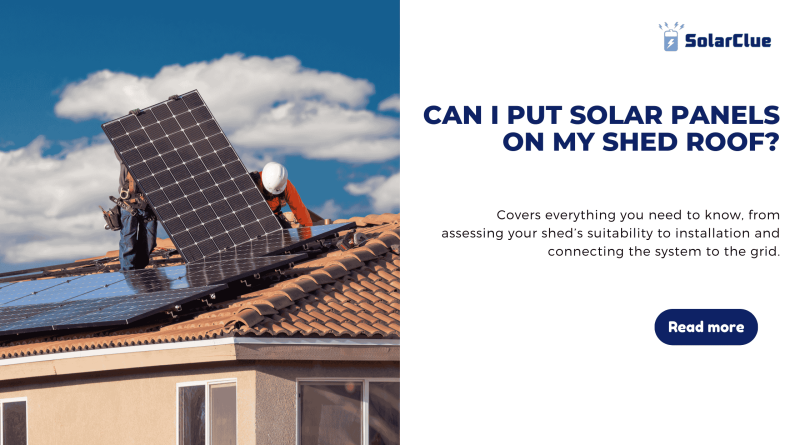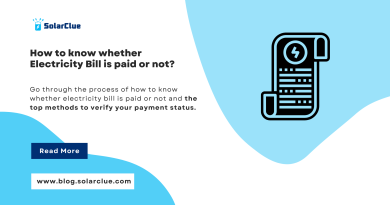Can I Put Solar Panels On My Shed Roof?
Installing solar panels on a shed roof is a practical way to generate renewable energy, especially for homeowners with limited roof space on their main house. This blog covers everything you need to know, from assessing your shed’s suitability to installation and connecting the system to the grid. We’ll explore potential challenges and solutions, ensuring a successful solar installation.
Table of Contents
- 1 Assessing Shed Suitability for Solar Panel Installation
- 1.1 Determining Optimal Solar Panel Size and Configuration
- 1.2 Obtaining Necessary Permits and Approvals
- 1.3 Installing Solar Panels on a Shed Roof
- 1.4 Connecting the Shed Solar System to the Main Grid
- 1.5 Energy Storage Options for Shed-Based Solar Power
- 1.6 Safety Considerations for Shed-Mounted Solar Panels
- 1.7 Maximizing Energy Production from Shed Solar Panels
- 1.8 Potential Challenges and Solutions
- 1.9 The Future of Shed-Mounted Solar Power Systems
- 1.10 Cost-Benefit Analysis of Shed-Based Solar Installations
- 1.11 Conclusion
- 1.12 FAQs
Assessing Shed Suitability for Solar Panel Installation
Before installing solar panels on your shed, it’s essential to assess whether the structure is suitable:
- Roof Size: Measure the available roof space to determine how many solar panels can be installed. Ensure the roof can accommodate the desired number of panels without overcrowding.
- Roof Orientation: South-facing roofs are ideal for solar panels in the northern hemisphere, as they receive the most sunlight throughout the day. East or west-facing roofs can also work but may require additional panels to achieve the same energy output.
- Structural Integrity: The shed’s roof must be strong enough to support the weight of the solar panels and mounting hardware. If the roof is old or damaged, it may need reinforcement or repairs before installation.
Determining Optimal Solar Panel Size and Configuration
Once you’ve assessed the shed’s suitability, the next step is to determine the size and configuration of your solar system:
- Energy Needs: Calculate your energy consumption to determine the size of the solar system required. Consider whether the system will power only the shed or feed energy into your home or the grid.
- Panel Size: Choose solar panels that fit within the available roof space while providing sufficient energy output. Standard residential panels are typically 60-cell or 72-cell, with varying wattage.
- Mounting Configuration: Decide whether to use a fixed mount, adjustable mount, or a tracking system. Fixed mounts are simpler and less expensive, while adjustable mounts or tracking systems can increase energy production by optimizing the angle of the panels.
Obtaining Necessary Permits and Approvals
Installing solar panels on a shed may require permits and approvals, depending on your location:
- Building Permits: Check with your local building authority to determine if a building permit is required for shed-mounted solar panels. Some areas have specific regulations for structures with solar installations.
- Electrical Permits: An electrical permit may be necessary if the system is connected to your home’s electrical system or the grid. Ensure that all electrical work complies with local codes and standards.
- Homeowner Association (HOA) Approvals: If you live in a community with a homeowner association, you may need to obtain approval before installing solar panels on your shed.
Installing Solar Panels on a Shed Roof
With permits and approvals in hand, you can begin the installation process:
Prepare the Roof: Clean the shed roof and ensure it’s free of debris. Reinforce the roof if necessary to support the weight of the solar panels.
Install Mounting Hardware: Secure the mounting hardware to the roof, ensuring it’s aligned correctly. The hardware should be attached to the roof rafters for maximum strength.
Attach Solar Panels: Mount the solar panels onto the hardware, making sure they’re securely fastened. Use appropriate sealing materials to prevent leaks where the mounting hardware penetrates the roof.
Wiring the System: Connect the solar panels in series or parallel, depending on your system configuration. Run the wiring through conduit to protect it from the elements.
Connecting the Shed Solar System to the Main Grid
If you plan to connect your shed’s solar system to the grid, follow these steps:
- Inverter Installation: Install an inverter to convert the DC power generated by the solar panels into AC power for use in your home or to send to the grid.
- Grid Connection: Hire a licensed electrician to connect the solar system to your home’s electrical panel and the grid. Ensure the connection complies with local utility requirements and safety standards.
- Net Metering: If available, sign up for net metering with your utility company. This allows you to earn credits for excess electricity generated by your solar system.
Energy Storage Options for Shed-Based Solar Power
Energy storage can enhance the efficiency and reliability of your shed’s solar system:
- Battery Storage: Install a battery system to store excess solar energy generated during the day for use at night or during cloudy weather. Choose a battery with the appropriate capacity for your energy needs.
- Off-Grid Systems: If you’re installing an off-grid solar system on your shed, battery storage is essential for ensuring a continuous power supply.
Safety Considerations for Shed-Mounted Solar Panels
Safety is paramount when installing solar panels:
- Electrical Safety: Ensure all electrical connections are made according to code, and use proper grounding techniques to prevent electrical hazards.
- Structural Safety: Verify that the shed’s roof can support the additional weight and wind load of the solar panels. Reinforce the structure if needed.
- Fire Safety: Keep wiring and electrical components away from flammable materials, and consider installing a disconnect switch for emergency situations.
Maximizing Energy Production from Shed Solar Panels
To get the most out of your shed’s solar system:
- Optimize Panel Angle: Adjust the angle of your solar panels to maximize sun exposure throughout the year. Use an adjustable mount or calculate the optimal fixed angle based on your latitude.
- Reduce Shading: Trim nearby trees or remove obstacles that could cast shadows on your solar panels, as shading can significantly reduce energy production.
- Regular Maintenance: Clean your solar panels periodically to remove dirt and debris that could reduce their efficiency. Inspect the system regularly for any signs of damage.
Potential Challenges and Solutions
Installing solar panels on a shed may present some challenges:
- Limited Roof Space: If your shed’s roof is too small to accommodate the desired number of panels, consider using high-efficiency panels or installing additional panels on another structure.
- Grid Connection Difficulties: If connecting to the grid is not feasible, consider an off-grid system with battery storage.
- Structural Concerns: If your shed’s roof is not structurally sound, reinforce it or consider installing the solar panels on a ground-mounted system instead.
The Future of Shed-Mounted Solar Power Systems
As solar technology advances, shed-mounted solar systems are becoming more accessible and efficient:
- Smaller, More Efficient Panels: Advances in solar panel technology are leading to smaller, more efficient panels that can generate more power in limited space.
- Integration with Smart Home Systems: Future shed-mounted solar systems may integrate with smart home technology for optimized energy management and automation.
- Increased Energy Independence: As battery technology improves, shed-mounted solar systems can provide greater energy independence, even for off-grid applications.
Cost-Benefit Analysis of Shed-Based Solar Installations
When considering installing solar panels on a shed, weigh the costs against the benefits:
- Initial Costs: Factor in the cost of solar panels, mounting hardware, inverters, wiring, and installation.
- Energy Savings: Calculate the potential savings on your electricity bill and any income from net metering.
- Return on Investment (ROI): Estimate the payback period for your investment and the long-term financial benefits.
Conclusion
Installing solar panels on a shed roof is a practical way to harness solar energy, especially for those with limited roof space on their homes. By carefully assessing your shed’s suitability, obtaining the necessary permits, and following proper installation procedures, you can create a functional and efficient solar system. With the potential for significant energy savings and the advancement of solar technology, shed-mounted solar power systems are a viable and sustainable option for many homeowners.
Here at SolarClue®, we offer a smart, practical, and “beautiful” solution. You will be answered for all the questions related to Solar.
We provide all kinds of brands that are the Best Solar panels in India.
If you are the one who is planning for the solar power system. Don’t hesitate to contact our team!
Looking forward to empowering you with solar energy, just like hundreds of our other clients!
FAQs
1: Can I install solar panels on any shed?
A: The shed must have a structurally sound roof with enough space and the correct orientation for solar panels. The roof should also be able to support the weight of the panels and mounting hardware.
2: Do I need a permit to install solar panels on my shed?
A: Yes, in most cases, you will need a building permit and possibly an electrical permit. Check with your local building authority for specific requirements.
3: Can I connect my shed’s solar system to the grid?
A: Yes, you can connect a shed-mounted solar system to the grid, but you’ll need an inverter and may require professional installation to meet utility requirements.
4: Is it worth installing solar panels on a small shed?
A: It depends on your energy needs and the size of the shed. For small energy requirements or supplementary power, it can be a cost-effective solution.
5: What maintenance is required for shed-mounted solar panels?
A: Regular maintenance includes cleaning the panels to remove dirt and debris, inspecting for any damage, and ensuring that electrical connections remain secure.


